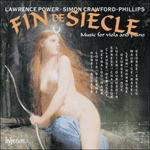
Welcome to Hyperion Records, a British classical label devoted to presenting high-quality recordings of music of all styles and from all periods from the twelfth century to the twenty-first.
Hyperion offers both CDs, and downloads in a number of formats. The site is also available in several languages.
Please use the dropdown buttons to set your preferred options, or use the checkbox to accept the defaults.

| Lawrence Power (viola), Simon Crawford-Phillips (piano)» More |
Soliloque et forlane was composed in 1937. It is dedicated to Maurice Vieux, Laforge’s protégé and successor as viola professor at the Paris Conservatoire. With its inclusion of a forlane, a baroque dance form favoured by French composers, Hahn’s work fits with wider neo-baroque trends. The work consists of two contrasting sections, Andante and Allegro scherzando, which are unified by the common key of E minor. The playful nature of the scherzando section is evoked through staccatos and pizzicatos, fast runs, and frequent double-stopping in the viola part, which also lend the music its virtuosic character.
from notes by Laura Hamer © 2016
Soliloque et forlane fut composé en 1937. Cette œuvre est dédiée à Maurice Vieux, protégé et successeur de Laforge comme professeur d’alto au Conservatoire de Paris. Avec l’inclusion d’une forlane, forme de danse baroque très appréciée des compositeurs français, l’œuvre de Hahn s’inscrit dans un courant néobaroque important. Elle se compose de deux sections contrastées, Andante et Allegro scherzando, unifiées par la tonalité commune de mi mineur. La nature enjouée de la section scherzando est évoquée par le biais de staccatos et de pizzicatos, de traits rapides et de fréquentes doubles cordes à la partie d’alto, ce qui prête aussi à la musique son caractère virtuose.
extrait des notes rédigées par Laura Hamer © 2016
Français: Marie-Stella Pâris
Soliloque et forlane entstanden 1937. Sie sind Maurice Vieux gewidmet, dem Meisterschüler und späteren Nachfolger Laforges am Pariser Conservatoire. Die Verwendung der barocken Tanzform der Forlane passt zur damaligen Neobarock-Mode. Das Stück besteht aus zwei kontrastierenden Abschnitten, Andante und Allegro scherzando, verbunden durch die gemeinsame Tonart e-Moll. Der Scherzando-Teil gewinnt seinen spielerischen Charakter aus staccato- und pizzicato-Spiel, schnellen Läufen und zahlreichen Doppelgriffen der Bratsche, die der Musik wiederum einen virtuosen Zug verleihen.
aus dem Begleittext von Laura Hamer © 2016
Deutsch: Marie-Stella Pâris
 Fin de siècle Fin de siècleAn irresistible programme of luscious French fare from one of the world’s foremost viola players.» More |

